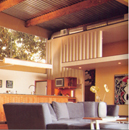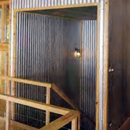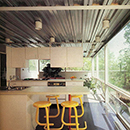
Corrugate
Corrugate refers to the cladding of interior surfaces with corrugated sheet material. more
Corrugate | House
application
Corrugate appears in residential interiors as a ceiling (the underside of a corrugated sheet metal or fiberglass roof), a wall surface and an interior of a transatlantic shipping container-house.
research
Corrugated sheet metal used for interior walls and ceilings evoke an industrial aesthetic, because the consistent, perfectly symmetrical ribs recall the mechanical rolling process responsible for its making, and because the material is used extensively for prefabricated structures. The industrial aspect also recalls the automobile industry which at one time denoted “the future,” perhaps why many have referred to aluminum houses as spaceships. To architect Edward Niles who designed the Sidley House (1989) in Malibu, California, the corrugate aesthetic equals honesty— “everything is all exposed. Everything is kept up front.”1
Corrugated materials for interiors caught the attention of multiple residential architects. In 1927, Buckminster Fuller conceived the Dymaxion House as the first prefabricated house made of corrugated aluminum sheets that assembled into kit parts. The design applied airplane construction techniques to the housing industry. Due to steel shortages the house was never constructed.2 It was not until 1931 that architect Albert Frey and Lawrence Kocher designed the first corrugated aluminum house, Aluminaire. Building the house was possible, because steel producers sponsored research concerning steel house construction.3
In World War II corrugated houses passed from being sporadically used as independent residences to being mass produced for housing developments. The war created housing shortages and the United States government hired George A. Fuller and Company to develop a prefabricated house that was “easily fabricated, portable, durable, and relatively comfortable” for war troops. The result was the Quonset Hut, which improved the Nissen Hut; “a lightweight structure developed by the British during World War I.” The new hut consisted of a sequence of curved steel ribs clad on both sides with corrugated sheet metal.4
In 1945, John Entenza launched the Case Study House program from which thirty-six prefabricated houses resulted. Among these, Case Study House #8 designed by Charles and Ray Eames relied entirely on industrially produced materials such as corrugated metal. “It was the idea of using materials in a different way, materials that could be bought from a catalog,” said Ray Eames, “so that there was a continuation of the mass production, so that people would not have to build stick by stick, but with material that comes ready-made off the shelf.”5 Albert Frey built two additional corrugated aluminum houses in Palm Springs, California, one in 1953 and the other one in 1964.
Architect Adam Kalkin deviated from the Eames’ conception of assembling prefabricated parts to compose the whole. Kalkin thought of the prefabricated element as a whole in itself; he experimented with using industrial shipping containers, with minimum interventions, as houses. In Berdardsville, New Jersey, a transoceanic shipping container became his home, “a testament to how personal prefab can be.” Further experimentation led Kalkin to create three containers as The Collector’s House (2001) for the Shelbourne Museum in Vermont. While the containers were dismantled to build the house, the resulting form resembled an enormous container; the box shape remained with several interventions for balconies and glass.6
In 2003 The Jennifer Siegal Company created Seatrain House comprised of four shipping containers. This 3,000 square foot residence is situated in a live-work artist community by the Brewery in Los Angeles. Siegal also created the Portable House that not only allowed the house to be moved monolithically, it also to expand its usable square footage once on the site. To accomplish this, she designed an independent module within a bigger container envelope that could be pulled out allowing for more space.7
Two years later, LOT-EK’s iteration of the shipping container house, the Modular Dwelling Unit (MDU) prototype, contained multiple extendable and retractable modules for different functional home-tasks: cooking, sleeping, bathing, studying, and storing. When all the modules were extended, the container itself became the corridor connecting all areas. LOT-EK refers to its container kit as a product that can be ordered from a house-wares catalog, planned and fabricated before reaching the site.8 Adam Kalkin showcased his Push Button House9 in the 52nd Venice Biennale of 2007, a shipping container that transforms into a five-room home with kitchen, dining room, bedroom, living room and library at the push of a single button.10
end notes
- 1) Burkhard Fröhlich and Sonja Schulenburg, Metal Architecture Design and Construction (Basel: Birkhäuser, 2003), 110; Elisabeth O'Brien, "Material Archetypes: Contemporary Interior Design and Theory Study" (MA Thesis, Cornell University, 2006), 60; Neil Jackson, The Modern Steel House (London: E & FN Spon, 1996), 209.
- 2) O’Brien, “Material Archetypes”, 62.
- 3) Jill Herbers, Prefabmodern (New York: Harper Design International, 2004), 19.
- 4) O’Brien, “Material Archetypes”, 61; Herbers, Prefabmodern, 20.
- 5) Herbers, Prefabmodern, 27.
- 6) Herbers, Prefabmodern, 27.
- 7) Herbers, Prefabmodern, 27; Adam K. Kaklin, Prefabs.com, http://www.dalygenik.com/ (accessed 15 May 2009); Office of Mobile Design, A Jennifer Siegal Company, http://www.designmobile.com/ (accessed 15 May 2009).
- 8) Herbers, Prefabmodern, 27.
- 9) Push Button House, http://www.illy.com/wps/wcm/connect/us/illy/art/project/push-button-house/
(accessed 15 May 2009) - 10) Evidence for the use and the chronological sequence of Corrugate as a house archetype was developed from the following sources: 1980 Charles Richter House [1985] Charles H. Richter, Partner of Fisher, Nes, Campbell; Ruxton, MD in Anonymous, "Architects' Own Houses," Architectural Record (Sep. 1965): 186; PhotoCrd: Anonymous; Hoekstra House [1985] David Hovey; Homewood, IL; in "Hoekstra House," Architectural Record, Record Houses 1985 (Mid-Apr. 1985): 81; PhotoCrd: Bill Hedrich, Hedrich-Blessing; House in Westchester County, NY [1985] R.M. Kliment and Frances Halsband Architects; Westchester County, NY in "House in Westchester County, NY," Architectural Record, Record Houses 1985 (Mid-Apr. 1985): 75; PhotoCrd: Cervin Robinson / 1990 Carraro House [1991] Lake Flato Architects; Kyle, TX in Gerald Moorhead, "Industrial Evolution," Architectural Record, Record Houses 1991 (Apr. 1991): 90; PhotoCrd: Paul Hester; Barry's Bay Cottage [1995] Hariri and Hariri, Architect; Ontario, Canada in Clifford A. Pearson, "Canadian Au Pair," Architectural Record 66, no. 4, Record Houses 1995 (Apr. 1995): 100; PhotoCrd: John M. Hall; John Sarli House [1995] Judith Sheine, Architect; Juniper Hills, CA in Karen D. Stein, "Desert Outcropping," Architectural Record 66, no. 4, Record Houses 1995 (Apr. 1995): 73; PhotoCrd: Grant Mudford / 2000 Hollywood Hills House of David Norbury [2003] John Sjoberg; Hollywood, CA in Deanna Kizis, "Go With the Flow," Interior Design 74, no. 3 (Mar. 2003): 178; PhotoCrd: Eric Laignel; Field House [2006] Wendell Burnette Architects; Ellerton, WI in Jane F. Kolleeny, "Field House," Architectural Record 77, no. 4, Record Houses 2006 (Apr. 2006): 126; PhotoCrd: Bill Timmerman.
bibliographic citations
1) The Interior Archetypes Research and Teaching Project, Cornell University, www.intypes.cornell.edu (accessed month & date, year).
2) Mendez, Marta. “Theory Studies: Archetypical Practices of Contemporary House Design.” M.A. Thesis, Cornell University, 2008, 63-75.



